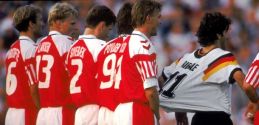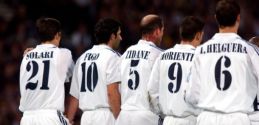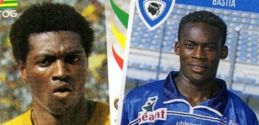A guide to the 2011 Copa America: Part Four – The Over-Achievers, Paraguay and Ecuador
Your fix of football that doesn’t contain gossip and speculation is here. Part four of David N’s guide to the Copa America.
PARAGUAY
Having firmly established themselves as one of the top four teams in the continent, Paraguay go into this Copa America with genuine hopes of winning it. This would be a great achievement, but then to raise Paraguay to its present level as a football nation has been an impressive achievement in itself. Paraguay is a relatively small nation, with a relatively small population, landlocked between the larger countries of Bolivia, Brazil and Argentina. But Paraguayans are famed as the toughest people in South America, and they delight in overcoming difficult odds.
They have done that, and then some. Having previously only done so in 1986, the national team has qualified for three of the last four World Cups, making it to the quarter finals in South Africa in 2010. Success in the Copa America is a more distant memory though, having come with wins in 1953 and 1979. But this generation of Paraguayan players, some of whom have been playing under coach Gerardo Martino since 2005 and may be playing their last tournament in Argentina, have the quality and experience to beat any of their continental rivals.
They consistently upset the “bigger” teams, beating both Brazil and Argentina in Paraguay in the qualifiers for South Africa. As their campaign in that tournament showed, they are, at the very least, extremely tough to beat, wringing a draw from Italy, beating Japan on penalties after another stalemate and losing by a single goal to eventual champions Spain. If they scored few goals at the World Cup, they can perhaps be excused. Their centre forward and best player, the stocky and skilful little Club America striker Sergio Cabanas, has not played since he was shot in the face in a bar in Mexico City in January 2010, though, displaying typical Paraguayan grit, he has apparently fully recovered. He has still not quite been replaced in the team, and goals will likely still be a problem for the Paraguayans.
That is hard to say with any certainty, for Paraguay are notoriously poor in friendlies, needing the heat of competition to play to their potential, so it’s impossible to say what sort of form they will bring to the Copa America.
Argentine coach Martino is a protege of Marcelo Bielsa, having captained the Newells Old Boys side coached by Bielsa, and he shares some of his mentors gifts without slavishly copying him. He likes to play a 4-3-3 but keeps it flexible depending upon the opposition. Facilitating this and providing much of Paraguay’s strength is a solid midfield full of impressive all-rounders like Enrique Vera of LDU Quito, Atalanta’s Edgar Barreto and Victor Caceres (right) of Paraguayan giants Libertad, who give their defence a screen but also support the strikers. Caceres may be the key player at the moment, providing a calm, disciplined fulcrum around which the rest of the team revolves, but an injury incurred in a recent friendly may well prevent him from playing. If that is the case, he will be replaced by either Olimipia’s Osmar Molinas, a disciplined holding player, or Oswaldo Martinez of Monterrey, more of an attacking midfielder who can also play as a support striker.
Behind this midfield lies an ageing but still impressive defensive line, the replacement of which may prove troublesome for the Paraguayans over the next few years. Wigan’s Antolin Alcaraz, Libertad’s Carlos Bonet, Zaragoza’s Sunderland flop Paolo DaSilva and Pumas’ Dario Veron are all in their 30s now, and Brazil in 2014 will probably be one tournament too far for them. But for the moment they remain a stubborn team, disciplined and hard to break down, except for the lack of a regular right-back.
As for a replacement for Cabanas up front, the most obvious successor appears to be the naturalised, Argentina-born Lucas Barrios (top). He has just completed an incredible season with Borussia Dortmund, winning the Bundesliga as one of their key players and scoring hatfuls of goals.
He could be part of a trio of attackers, with Roque Santa Cruz filling another of the spaces in what he claims will be his final competition. An ailing veteran at 29, a fully fit “Rocky” is still a potent weapon, terrifying in the air, handy on the ground, able to score goals and link the play. His inclusion may seem odd to European fans when they see that Benfica’s Oscar Cardozo has been left out. Prolific and effective in Portugal, he has never impressed for his country, scoring five goals in 37 games, and Paraguayan fans are not as wowed by European success as we might like to think, so his exclusion has barely been noticed.
Likely to compete to play upfront alongside Santa Cruz and Barrios are Edgar Benitez of Pachuca and Haedo Valdez of Hercules, each of whom can play on the flank and score goals. Valdez is also dominant in the air, and he and Santa Cruz formed a formidable, dominant partnership in a recent friendly against Bolivia.
Despite this slight worry over where goals will come from, Paraguay will approach their games with confidence. They share Group B with the eminently beatable Venezuela, Ecuador, and the not-quite-so-beatable Brazil. They will go into all of those games absolutely without fear and with the reasonable belief that they can win the group. Once that is accomplished, or more likely if they snag second spot, they will be only three games from winning the tournament, and anything can happen.
ECUADOR
Ecuador are in a tricky transitional phase. The golden generation of players who drove them to the unprecedented success of two World Cup tournaments in 2002 and 2006 (when they reached the last 16) is breaking up and there seem to be no equivalently talented young players bound to replace them.
The rise of Ecuador over the last fifteen years or so is an amazing story considering that prior to 2002, they had never qualified for a World Cup. Their Copa America record, however, is still abysmal, since they rarely go any further than the group stage - even in this period of World Cup success.
Partly this is down to a change in CONMEBOL’s qualifying system. The introduction of a marathon single group stage, meaning each country played each of the others home and away for the 1998 World Cup, immeasurably assisted the likes of Ecuador, who are fearsome at home at altitude in Quito. This combined with the rise of a group of players led by centre-forward Agustin Delgado and a strong defence centred on Ivan Hurtado, and the arrival of a series of Colombian coaches who imported some of that countries football culture and nous and allied it to Ecuadorean speed and strength to create an extremely competitive and talented team.
But Delgado and Hurtado have both retired, and their replacements are simply not of the same calibre. Almost the entire defence plays for one of the two giant Quito clubs - LDU or Deportivo - with only captain Walter Ayovi playing abroad, for Monterrey. Coincidentally he is the only really outstanding player in the backline, a marauding wingback who likes to shoot from distance.
The two starting forwards will be familiar names to English fans: Cristian “Chucho” Benitez, who, two years ago, had a loan spell at Birmingham City from his parent club, Santos Laguna of Mexico; and Felipe Caicedo (above) of Manchester City, who spent last season very successfully on loan at Levante. Caicedo was the wonder boy of Ecuadorean football a few years back, but hasn’t quite met expectations, though his form this season has been encouraging. Benitez is a big game player for his country, a creator and finisher and a prodigious workhorse, with a record of 15 goals in 36 games for his country. Caicedo’s Levante team mate, Jefferson Montero, is the best option off the bench, a tricky second striker, with Jaime Ayovi representing plan B.
Colombian Coach Reinaldo Rueda, who did well to get Honduras to the 2010 World Cup, generally likes a 4-4-2, with his creativity coming from the wings in the form of Manchester United’s Antonio Valencia (left) and Michael Arroyo of San Luis. In the centre he prefers solidity, with the experience of Segundo Castillo alongside Cristian Noboa’s string-pulling. Midfield is probably Ecuador’s strongest area, and it ensures their games are generally tight battles, though defensive deficiencies have hurt them of late.
They join Paraguay and Venezuela in Brazil’s group, and seem to partly view this tournament as a rehearsal for qualifiers for 2014, when Rueda will be better settled in the job and a few of his younger players may have grown into the team.
More of David N’s musings on football from South America and beyond can be found on GolGolGolGolGol and also on his Twitter page.
Tags: , , , , ,Share this article
Leave a comment
- When did co-commentary become such a serious and miserable business?
- Why do we devote so much time to sharing our love of football for free?
- Villa’s Tokyo downfall: The apparent formality of a world title match
- Son Heung-min and the forgotten wonder goals
- Guess the Premier League goalscorer from the GIF
- A fateful flight
- Goodbye to the instant analogue gratification of Ceefax
- Player Profile: Steve Ogrizovic
- Rejecting FA Cup money in favour of a car boot sale
- It’s a man’s world? Former Arsenal manager crosses the gender divide











